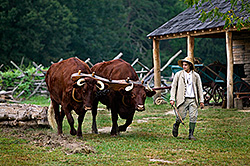Page content
Historic Farming
Livestock - Cattle
Contrary to popular belief, Virginians ate as much beef as pork. Most middling sort farmers owned at least a few black cattle. Colonists did not refer to their bovine stock with specific breed names, but grouped them under the archaic and general terms of common, neat, native, or black, without consideration of heritage, color, or pattern. Although gentry planters began to import improved English breeds during the late 18th century, they had little effect on the native cattle that were raised almost universally.
Most cattle weighed 750 to 900 pounds and were used more for meat than dairy. They took 5 to 7 years to mature. Their provisions were meager, and, like horses, they foraged for much of their food. Lean meat and poor milk of limited quantity were the usual products of these animals. Any cattle trained for work were considered oxen. They were cheaper to acquire and keep than horses, they could pull heavier loads, and they could be eaten at the end of their working lives.
Spring was a critical time for cattle. Mortality rates rose in the cold, wet winter months when there was little to eat. Cattle that survived to March were rounded up, the new calves were branded with their owner’s mark, and young bulls not selected for breeding were castrated. A castrated bull is called a steer. Cattle grew fat by foraging through the summer; they were slaughtered for beef and leather in the fall.
As the Tidewater became more densely populated, forests were depleted for firewood, lumber, and crops. Free-ranging stock suffered heavily, and as a result, more farmers turned to penning their cattle on grazing ground. According to historian David Percy, “the path of settlement might well be traced by the planting of pastures.”

